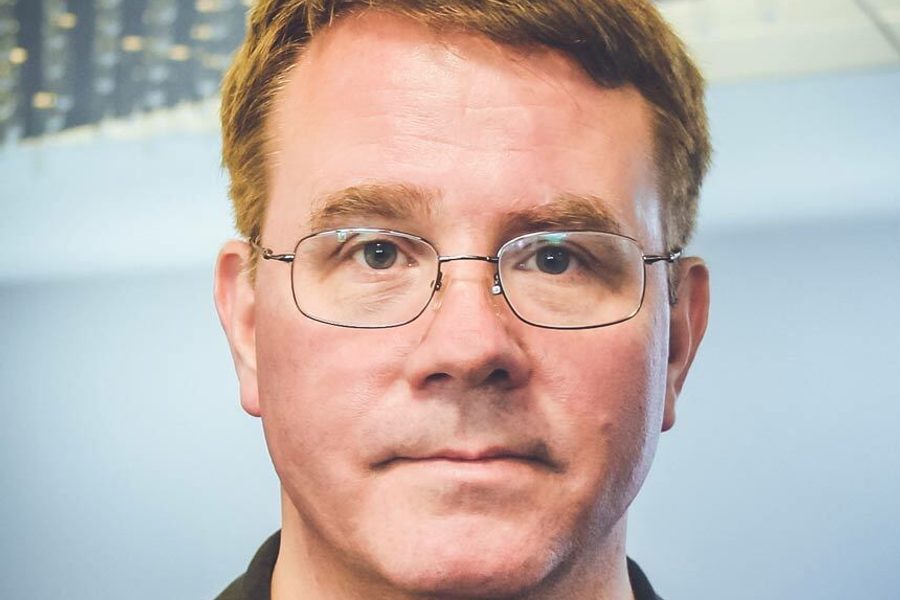Meet the Green Chemist Who Is Out To Make Chemicals Less Toxic for Humans and the Environment
John Warner brings us Green Chemistry, challenging chemists’ toxicology standards.
Valerie Brown

The phrase “green chemistry” has entered our vocabulary in response to the fact that industrial chemistry as currently practiced produces thousands of harmful compounds. With more than 80,000 chemicals in use in the United States and government regulation at a standstill, the chemical industry’s business as usual continues to expose billions of people and other organisms to substances that kill them outright or cause long-term changes in their physical and mental functioning. Green chemistry seeks to answer questions about chemicals’ safety — their human and environmental health effects, as well as the amount of waste produced by their manufacture — before they enter the marketplace.
John Warner is one of the founders of the green chemistry movement. After earning a Ph.D. in chemistry from Princeton University in 1988, Warner worked for Polaroid for nearly 10 years and then taught chemistry as well as community health and sustainability at UMass Boston and Lowell. With former EPA science advisor Paul Anastas, Warner coauthored Green Chemistry: Theory and Practice, a seminal text that presented 12 principles for chemists designing new molecules and materials.
Warner is currently president and chief technology officer at the Warner Babcock Institute for Green Chemistry in Wilmington, Mass. In 2014, the Society of Chemical Industry awarded him its Perkin Medal, the highest honor in applied chemistry. He spoke with In These Times about how to change the way industrial chemistry is practiced.
Where did green chemistry come from?
Two narratives explain the emergence of green chemistry. Narrative one has to do with business efficiency. Say a company hires bright scientists out of the universities and they come up with a really bright invention. They get excited and spend a bit of money on it, and then at some point someone says: “But wait a minute, you used a solvent that the EPA won’t let us use. You used a reagent — a compound used to detect the presence of other chemicals by reacting with them — that is expensive because of all the regulations around it.” So companies get frustrated because their scientists waste time inventing things that can’t be done.
The second narrative is the moral and ethical component. That is: You read all these stories on the Internet or hear on the radio that this causes something bad and you ask yourself, “Why would a chemist make something toxic in the first place?”
I have a Ph.D. in chemistry from an Ivy League university. I never had a class in toxicology. You will not find one college or university that requires a chemist to have any knowledge of toxicology or environmental mechanisms. That should stagger you.
How did green chemistry come to be?
In 1991, the question that we had was: “Are there people meeting and publishing articles in journals about how to make things that are non-toxic, environmentally benign?” The answer was no. No field of science existed that could bring that together, either intellectually or practically. The reason we needed a field called green chemistry was to provide journals, to provide workshops, to provide conferences, to provide textbooks, to provide classes.
Of all the stakeholders — industry, academia, government — which has been the most responsive to the idea?
While I was at Polaroid, I invented a technology that was very different. We wanted to go to large-scale manufacturing. In the U.S., you have to get approval by the EPA. So we submitted our documentation and the EPA rejected the application. Not because of toxicity, not because of environmental impact, but just because it was different and weird and strange. The EPA said that because it’s different we’re going to make it difficult to regulate. Well, isn’t anything that is better for the environment going to be different?
When my book came out in 1996, within three years every major company had a green chemistry program. Industry immediately got it. If we could come up with ways of making safer products, they would get to markets faster, the liability costs would be lower and they would be more profitable. We haven’t seen that happen in academia.
Why is that?
Academia is slow to change. If you were to look at the top 10 chemical reactions run in the world, most of them have been invented in the last 20 years. None of them are in textbooks.
What do you see as the obstacles to green chemical principles in academia?
There are two “tribes of science’’ — the makers of knowledge and the makers of materials. In the 1960s, when the environmental movement emerged, people who were interested in toxicity and environmental impact became those who were making knowledge and studying things. The people who were making things got even more distant. Green chemistry is saying, “Let’s get the makers of knowledge and the makers of things sitting at the same table and make this practical.”
Are these two groups like oil and water?
You grow up and there’s a group of people in high school that are all politically active. They don’t usually want to be chemists. The ones who want to be chemists are the ones who, for whatever reason, aren’t really interested in— or maybe are even repulsed by — the squishy side of society. If green chemistry is presented in this moral and ethical, touchy-feely, we-should-do-thisto-save-the-trees way, the very people you want to embrace it are turned off. What most people outside of the sciences would think is a wonderful driver, in a weird and twisted way, isn’t. That’s why I tend to instead talk about green chemistry in terms of competitiveness and the intellectual challenge.
Do the chemist wannabes think the squishy part is not rigorous enough?
Yes. By definition, the squishy stuff cannot be rigorous. The mistake that people make is to think, “If you’re a good chemist, you do chemistry. If you’re not a good chemist, you’ll do green chemistry.” That is just not correct.
Everyone has their own take on green chemistry. Some are more fire-andbrimstone, “You’ve got to do this because it’s the moral and ethical thing.” They downplay the intellectual challenge and the science of it and make it a moral diatribe. People are turned off by that. It’s not that it’s untrue or unimportant, but that’s not how you get people to get involved — to tell them they suck. The way you get people involved is to say, “This is an amazing challenge.”
This isn’t an unsolvable problem. Universities could train chemists to understand mechanistic toxicology and environmental impact. If they did, can you imagine what the future would be? All of a sudden there is an actionable path forward.
From my perspective, anyone who sets out to make a molecule should be asking himself or herself, “The thing I’m about to make: Is it going to be the most potent neurotoxin in history or not?” Right now we are not giving chemists the skills to ask that question. You tell me, could anything in the curriculum be more important than that?
So how do you accomplish that?
You have a class in mechanistic toxicology. They don’t have to become experts. You can scream at a company to make safer products, but if they don’t know how, it doesn’t matter.
Companies are interested in green chemistry because they think it’s going to be easier and cheaper. Do they think it’s also going to reduce regulation?
This is always a controversial question. Imagine a world where we don’t need regulations because everything is safe. What a wonderful world that would be. That’s not saying, “Let’s not have regulations.” It’s saying, “Imagine a hypothetical world where they were unnecessary.” Working toward that future is a wonderful goal. We’ll never get there, but it is a direction to work toward.
Sometimes people get confused. They say, “Oh, you’re going to do that instead of regulations.” Nothing could be further from the truth. For the next several decades we’re going to need regulations, but if in 50 to 100 years, we’re still dependent on regulation to keep us safe, we’re probably going to be in pretty serious trouble.





